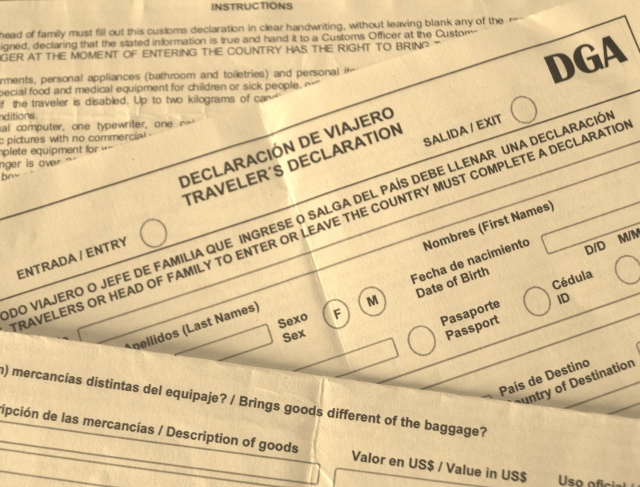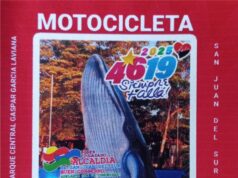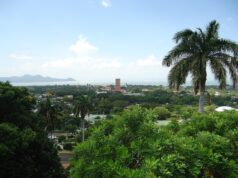Passing through customs when entering Nicaragua can be anything from very simple to very complicated depending on; the type and amount of goods the traveler is bringing in, their understanding of the process and the discretion used by the customs official(s) at the time.
Not everyone is a seasoned traveler and it’s quite normal to be a little overwhelmed with everything that’s going on when entering a different country. Its easy to miss something if you can’t understand everything that’s being said. Hopefully this article might help avoid some unnecessary problems and/or unexpected payments.
The Declaration Process
Nicaragua uses the typical “Autodespacho” (self-dispatch) or self-declaration/clearance system whereby the onus is on the traveler to provide the information (on a preprinted form) relating to regular luggage and/or other merchandise they are bringing in. The separation of those two distinct categories (regular luggage and other merchandise) seems to be at the root of most of the typical traveler complaints in relation to the process.
New Style Self Declaration Customs Form (for entering or leaving Nicaragua)
All travelers are required to go through customs when entering Nicaragua at either a border crossing or airport. Normally your carrier will give you a copy of the Declaración de Viajero (Travelers Declaration), if not; you can request one from the customs point at entry.
Each traveler (or head of family) must hand over their customs declaration at the customs point. By submitting the (usually signed) form, you have made your declaration. The time for asking questions or working out allowances is over at that point. Customs will either let you pass through (after your baggage has been scanned if that process is available), or call you forward for further questions based on your declaration.
Regular Luggage
As stated on the declaration form, “Every passenger at the moment of entering the country has the right to bring in tax free the following items;
- Personal effects required for his/her trip; clothing, articles for personal use, bathroom items, recreation items, special food, therapeutic, orthopedic equipment for children or the infirm and “Medicines in quantities according to the circumstances and needs of the traveler”.
- Also as part of that “tax exempt personal baggage”, the declaration form states that you are allowed to bring in; one photographic apparatus, one item for recording images (video camera), one portable sound recording and reproducing device, one portable musical instrument, one laptop or typewriter (it’s based on old law!).
- You may also bring in “tools or utensils related to your art, occupation or profession that don’t form part of a complete workshop or similar” (e.g. water colors and an easel).
- “Duty Free” – If the declarant is over 21, they may bring in 20 packs of cigarettes or 50 cigars or five hundred grams of manufactured tobacco and five liters of alcoholic beverages for each traveler.
- Up to two kilos of candies.
- If the traveler has been out of the country for a minimum of 72 hours, they can bring in merchandise (other than regular luggage) worth up to US $ 500 See Below.
- Other goods determined by their quantity and nature are intended for personal use and cannot be considered “commercial quantities”, a decision that ultimately will be made by customs.
Note: Although exempt from paying taxes, regular (personal) luggage can be subjected to a random check as part of the customs verification.
Merchandise other than Luggage
US $500 Exemption
As stated above, the difference between regular luggage and other merchandise is where a lot of travelers get into difficulties. Not helping are some gray areas as to who qualifies for the US $500 tax free exemption.
The customs declaration form says “Every passenger at the moment of entering the country has the right to bring in tax free the following items”… and goes on to list one of those items as US $ 500.00 worth of merchandise that is tax exempt providing the traveler has been out of the country for 72 hours.
However, on the DGA (Dirección General de Servicios Aduaneros) website under Frequently Asked Questions it states that this US $500 exemption is available to travelers of Nicaraguan nationality only. They must have completed 6 months since a previous similar US $500 exemption was granted (which gets noted on their passport). Also, the three days (72 hours) out of the country does not include the day of departure and the day of return. Lastly, the goods cannot be considered commercial quantities.
It specifically says: “Those of a foreign nationality will have to pay the taxes on the said merchandise.”
Either way, foreigner or national, you need to declare the US $500 merchandise on the customs declaration form under “goods different to your baggage” (meaning allowance, not necessarily physically separate) in order to request the exoneration.
Depending on how this is interpreted on the day, you may have to pay tax and/or duty on the item(s).
US $2,000 Merchandise – No Requirement for Customs Agent
The other category open to those bringing in merchandise with them (other than their luggage allowance) at the time of their entry is a maximum of US$2,000 worth of permitted merchandise in non-commercial quantities. The law establishes that passengers who wish to do this may complete a special declaration form and pay the duty and/or taxes without using the services of a Customs Agent to clear it. However if the value of the merchandise is deemed to be greater than that declared on the declaration form(s), you will be required to carry out a clearance through a Customs Agent.
Bringing in Cash and/or Equivalents
On your declaration form you are required to declare the value of any cash, securities, objects, precious metals or a combination of those items you are bringing in where any or all of those items amount to more than US $10,000. Also if in a 30 day period, a traveler has entered Nicaragua more than once, they must make a declaration when the combined amount reaches US $10,000 during that 30 day period.
Note: On the DGA website and in the law relating to Aduana you will find reference to the Central American Peso ($ CA). This currency (from 1961) was used by the institutions belonging to the Central American Integration System and is equal to US $1 (one US Dollar). The Central American Import Tariff is expressed in Central American Pesos; hence it made it into the Aduana laws here in Nicaragua.







